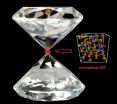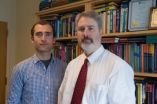(Press-News.org) Scientists from the Kavli Institute of Nanoscience at Delft University of Technology have discovered a key element in the mechanism of DNA repair. When the DNA double helix breaks, the broken end goes searching for the similar sequence and uses that as a template for repair. Using a smart new dual-molecule technique, the Delft group has now found out how the DNA molecule is able to perform this search and recognition process in such an efficient way. This week, the researchers report their findings in Molecular Cell.
A staggering problem
Sometimes, the DNA double helix gets broken: both strands are accidentally cut. This presents a vital problem because cells cannot cope with such damaged DNA. Genomic DNA instabilities such as these, are a known cause of cancer. The good news is that an intricate DNA repair system exists which is impressively error-proof and efficient. How does this work?
First, proteins form a filamentous structure on the broken DNA end. Second, this filament examines recently copied DNA or the second DNA chromosome (remember that we have two copies of each chromosome) in search of a DNA sequence that matches that of the broken end. Note that this is a daunting task: given that, for example, our human genome contains three billion base pairs, finding your few hundred base pairs of interest, is really like finding a needle in a haystack.
'Still this search process occurs within minutes and with great efficiency. How that is achieved, has been a mystery for decades. The new experiments from our group now resolve this by revealing the key step in the process, the molecular recognition step', says scientist Iwijn de Vlaminck, who was the postdoc that did the experiments in the group of prof. Cees Dekker at Delft.
Search operation
'In bacteria, the so-called RecA protein is responsible for conducting the search operation. In E. coli bacteria, a filament of RecA protein formed on DNA, searches and pairs a sequence within a second DNA molecule with remarkable speed and fidelity. To do so, individual molecules of RecA first come together to form a filamentous structure on the broken DNA. The filament then grabs DNA molecules in its vicinity and compares their sequence to the sequence of the broken DNA. When a sequence match is found, both molecules bind tightly to one another allowing repair to ensue', says De Vlaminck (since recently at Stanford University).
'We found that the filament's secondary DNA-binding site interacts with a single strand of the incoming double-stranded DNA during homology sampling. Recognition is achieved upon binding of both strands of the incoming DNA to each of two DNA-binding sites in the filament.'
The data indicate that the fidelity of the search process is governed by the distance between the DNA binding sites. The Delft experiments clarify what exactly happens in the sequence comparison of the two molecules, making clear why a 'wrong' sequence leads to quick dissociation of the molecules while a 'correct' sequence makes a strong bond leading up to further repair. These are the two elements that lead to the impressive speed and high efficiency of the DNA repair process.
New instrument
The team from TU Delft developed a unique new instrument that makes it possible to independently manipulate an individual DNA molecule and an individual RecA filament and to measure the strength of intermolecular interactions. This dual-molecule manipulation instrument combines magnetic-tweezer and laser-trapping-based DNA-molecule manipulation with a laminar flow system. The setup also allowed to unwind the DNA helix a bit, thus opening local regions where the normal duplex was destabilized. This effect turned out to be crucial for the molecular recognition process. Thus, the team was able to directly probe the strength of the two-molecule interactions involved in search and recognition and build a new model for it.
INFORMATION:
A needle in a haystack: How does a broken DNA molecule get repaired?
2012-05-04
ELSE PRESS RELEASES FROM THIS DATE:
Research Now Launches Valued Opinions 2.0 in Australia
2012-05-04
Research Now, the leading global online sampling and data collection company, today announced the gradual launch of its improved Valued Opinions programme to over 200,000 active members in Australia. Enhancements include: a modernised website and new identity; increased member communications and support resources; access to a complete history log; social media integration; the introduction of quick polls; a greater variety of rewards; and a complimentary Smartphone app.
Since its first launch in the United Kingdom in April 2011, Valued Opinions 2.0 has seen a 25-30 ...
Fast, low-power, all-optical switch
2012-05-04
An optical switch developed at the Joint Quantum Institute (JQI) spurs the prospective integration of photonics and electronics. What, isn't electronics good enough? Well, nothing travels faster than light, and in the effort to speed up the processing and transmission of information, the combined use of light parcels (photons) along with electricity parcels (electrons) is desirable for developing a workable opto-electronic protocol.
The JQI (*) switch can steer a beam of light from one direction to another in only 120 picoseconds (120 trillionths of a second), ...
funK shades Expands Children's Sunglass Line With New Shades & Bright Spring Colors
2012-05-04
funK shades, the first makers of polarized children's sunglasses with snap-on charms, is bringing vivid spring colors and fashion-forward new styles to their Spring/Summer collection. With everything from chic neon pinks to breezy ocean blues, funK shades are 100% UVA UVB polarized lenses protecting children's eyes from harmful UV rays with both style and funKtion.
Just in time for summer, funK shades have added fashionable flair to its already adorable line of children's sunglasses. The new folding Wayfarer inspired frames are portable, compact, and perfect to endure ...
Scientists core into California's Clear Lake to explore past climate change
2012-05-04
University of California, Berkeley, scientists are drilling into ancient sediments at the bottom of Northern California's Clear Lake for clues that could help them better predict how today's plants and animals will adapt to climate change and increasing population.
The lake sediments are among the world's oldest, containing records of biological change stretching back as far as 500,000 years.
The core drilling is part of a unique, multifaceted effort at UC Berkeley to determine how Earth's flora and fauna responded to past changes in climate in order to improve models ...
Blacks and Hispanics at higher risk for precancerous colorectal polyps
2012-05-04
New York, NY (May 3, 2012) — Blacks and Hispanics have a significantly higher risk of developing precancerous colorectal polyps compared with whites, according to a study by researchers at NewYork – Presbyterian Hospital/Columbia University Medical Center. The findings appeared in the online edition of Alimentary Pharmacology and Therapeutics.
"Our data suggest that we need to redouble our efforts to increase colon cancer screening in areas with large numbers of racial and ethnic minorities," said lead author Benjamin Lebwohl, MD, MS, assistant professor of clinical medicine ...
New UF study shows early North Americans lived with extinct giant beasts
2012-05-04
New York, NY (May 3, 2012) — Blacks and Hispanics have a significantly higher risk of developing precancerous colorectal polyps compared with whites, according to a study by researchers at NewYork – Presbyterian Hospital/Columbia University Medical Center. The findings appeared in the online edition of Alimentary Pharmacology and Therapeutics.
"Our data suggest that we need to redouble our efforts to increase colon cancer screening in areas with large numbers of racial and ethnic minorities," said lead author Benjamin Lebwohl, MD, MS, assistant professor of clinical medicine ...
Thanks for the memory: More room for data in 'phase-change' material
2012-05-04
A team led by Johns Hopkins engineers has discovered some previously unknown properties of a common memory material, paving the way for development of new forms of memory drives, movie discs and computer systems that retain data more quickly, last longer and allow far more capacity than current data storage media.
The work was reported April 16 in the online edition of Proceedings of the National Academy of Sciences.
The research focused on an inexpensive phase-change memory alloy composed of germanium, antimony and tellurium, called GST for short. The material is already ...
What Big Skin Care Companies Don't Want You to Know
2012-05-04
If you are one of the millions of Americans suffering from the pain of dry cracked skin, chances are you've searched the aisles of your local drug store for a cure only to be disappointed by product after product. And most likely you've invested hundreds of dollars over the years on lotions that just end up sitting on your bathroom shelves or in the trash.
You are not alone.
Wonder ingredients that go nowhere:
The skin care industry is a multi-billion dollar industry with companies racing to create the newest wonder ingredients and fight for top celebrity endorsements ...
Geisel researchers sift through 'junk' to find colorectal cancer clues
2012-05-04
Two researchers at the Geisel School of Medicine at Dartmouth have helped to identify switches that can turn on or off genes associated with colorectal cancer. The finding offers clues about the development of colorectal cancer and could—potentially—provide targets for new therapies. Jason Moore, Third Century Professor of genetics and the director of the Institute for Quantitative Biomedical Sciences, and Richard Cowper-Sal.lari, a graduate student in Moore's lab, were part of a team that included researchers from Case Western Reserve University and the Cleveland Clinic. ...
Rob DeVincent of Corcentric to Co-host The Children's Place Procure-to-Pay Case Study Session at IOFO's Fusion 2012
2012-05-04
Corcentric, a leading provider of Accounts Payable automation solutions, today announced Rob DeVincent will be co-hosting an educational session at the Institute of Financial Operations' 2012 Fusion Conference, the largest conference for AP professionals and professionals working in all areas of financial operations. The session titled "The Retail Advantage: Case Study on P2P Automation at The Children's Place," is session #1710 in the AP, P2P, and TAWPI focus disciplines. This session, which offers one Business Management and Organization credit to attendees, ...




